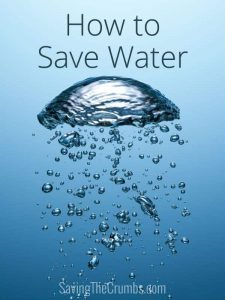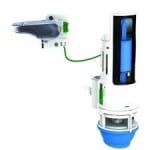Water is our most precious resource it has often been said. Both Deb and I grew up in California and we still have many friends and family living there, so we aren’t unfamiliar with the ever-looming specter of drought. (Especially in recent years.) Conserving water has a far greater impact than simply cutting down our water bill today, but it’s preserving the resource for the future as well.
The tips below are divided into two categories. Tips and techniques that cost nothing, and those that involve an upfront investment for greater savings down the road.
No Cost Options
- Turn off the faucet while you brush your teeth. It seems obvious, but it’s amazing how many people leave the faucet running habitually. While you’re at it, turn it off while you soap up in the shower too!
- Save the water from washing the vegetables to water your plants. My grandma always told me to use the water we wash our rice with to water the garden. She said it was good for the plants, but now I know it was even better for the water bill! Any wash water that isn’t contaminated with soap and scum can be used for this purpose.
- Collect the water from your shower while it gets hot. Have a bucket by the shower and gather that water that otherwise would go down the drain and use it to water your plants, flush the toilet, or save it for an invigorating end-of-shower cold-water rinse. It’ll save water AND boost your immune system!
- Take shorter showers. I confess that long, hot showers are one of my favorite indulgences (especially in the dead of winter), but there’s no denying that showers use a ton of water. Shorter showers also save on the hot water heater too…just make sure you actually get clean, though!
- Decrease the amount of laundry you do. Wear your clothes more times between washes. A pair of pants worn from a clean house to a clean workplace in a clean car doesn’t need to be washed after only one use. You’ll also save your clothes from the wear and tear of unnecessary trips through the wringer.
- Wash your dishes by hand instead of a dishwasher. That’s right, all your Asian friends do this for a reason. Dishwashers are convenient but they use TONS of water.
- When washing dishes by hand, use water baths instead of running the faucet. Plug the sink or use some dish pails for your wash and rinse water. The less your faucet runs, the more water you save.
- Gather rainwater for outside uses. Be it in buckets, large drums, cisterns, or some other container, rainwater can be collected for a variety of uses. Watering the garden, watering pets, washing the car, or maybe even washing your hair!
Investment Options
As we discussed in the Everyday Investing post, getting a healthy return on your money doesn’t necessarily mean throwing money into the stock market. Intelligent purchases that increase efficiency and reduce recurring costs can sometimes beat the socks off of even the most optimistic stock market returns. Here are just a few ideas:
- Install Low Flow Faucet Aerators. $2.50 each. Most standard faucet aerators (the nozzles that screw onto the faucets in your sinks) run at a rate of 2.2 gpm (gallons per minute). By replacing them with these 0.5 gpm low-flow faucet aerators, you immediately save over 75% on all water usage through your faucets at home. The best part is, the spray pattern (as opposed to a solid column of water) actually makes the water cover more surface area at higher pressure so it can actually rinse BETTER than standard aerators. The only time the low flow is an issue is when we’re trying to fill up a big pot or something, and we use our retractable kitchen sink sprayer for those jobs.
- Install Low Flow Showerheads. $8 each. Similarly, most standard showerheads run at 2.5 gpm. By switching to this 1.25 gpm showerhead, you immediately save 50% on all your showers. It’ll take a few days to get used to the different feel from the showerhead, but we’ve found the coverage to be just as good. This is a major double-win because showers are the biggest source of hot water usage, so you will save a lot on energy for the hot water as well. In my opinion, these two low flow devices are no-brainer upgrades to any home. They’ll pay for themselves in a matter of months, especially in places with high utilities.
- Convert the Toilet to be Dual Flush. $20-35 each. Toilets with dual-flush mechanisms are common in many parts of the world, but somehow in the US we still think that flushing a full tank (which sometimes is as much as 7 gallons!) is necessary even for small amounts of liquids. Make your existing toilet dual flush with a simple conversion kit (took me 15 minutes to install) and then train your family on the difference between a half-flush and a full flush. The amount of water saved will vary on your tank size and how you adjust the unit, but some estimates say that a family of 4 can save more than 15,000 gallons per year by simply having the dual flush toilet.
- Use a Front-Load Washer. These washers beat the old, center agitator-style top load washers in multiple ways. They use as little as one-third the amount of water, a fraction of the detergent, as much as 30% less electricity, and they’re far gentler on your clothes, making them last longer. Not to mention, they spin dry your clothes far more efficiently so the clothes will dry quicker. (This will theoretically help save on dryer usage, but since we’re Crumb Savers, we hang dry our clothes anyway. 😉 ) Consider this as an option the next time you need a new washer, it’s unlikely to be a worthwhile payoff if you’re replacing a perfectly good washer for a new front-loader.
- Use drip irrigation for your garden. Watering below the leaf cover, directly to the roots of the plants will save loads of water from evaporation. Add a nice mulch layer and you may not have to water much at all (depending on where you live, of course)!
- Modify your landscaping. In California, many people are turning to rock gardens to landscape their house tastefully yet eliminate the need for water. Another strategy is to focus on using native plants that are acclimated to the region’s amount of rainfall. Or you may even consider turning your lawn into a garden so at least you’re watering something that will feed you later! We had a bare patch at our place that needed some ground cover, so instead of plain ol’ ivy, we planted sweet potatoes that we sprouted from an old one we got from the grocery store.
Conclusion
These are just a few ideas to save water. Applying some of these techniques, our monthly water bill has been consistently around $10 each month here in Tennessee. Of course the price of water varies widely around the country, but applying even a few of these strategies can mean thousands of gallons being saved right away.
What tips or ideas did we miss? Share what you’ve done to save water in the comments below!










